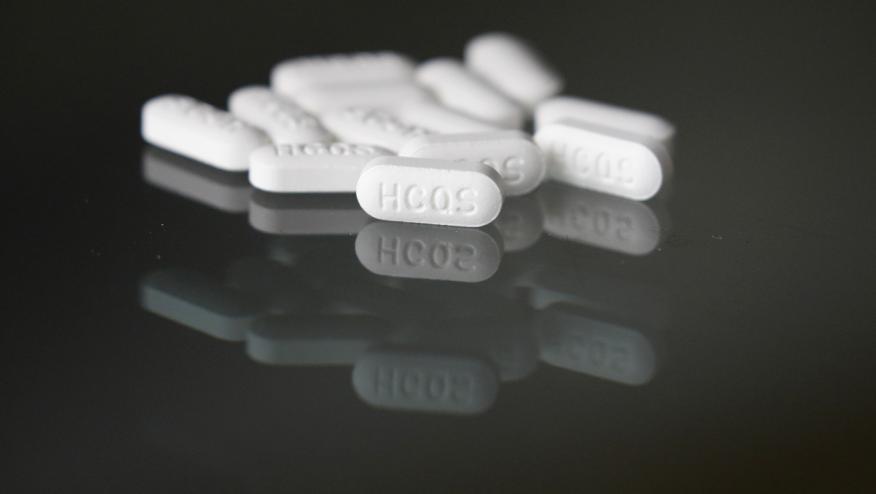Older Lupus Patients Can Stop HCQ Without Increasing Flare Risk Save

Withdrawal of hydroxychloroquine (HCQ) in older patients with stable systemic lupus erythematosus (SLE) did not increase the risk of disease flares, according to a small, retrospective, multicenter study.
Despite its lengthy safety record, the greatest concerns for patients taking HCQ (typically prescribed at ≤6.5 mg/kg of body weight) are vision problems. Many rheumatologists recommend annual ophthalmologic checkups for patients taking HCQ to recognize early toxicity. This is because evidence from the literature has suggested that rarely occurring ocular toxicities may be associated with HCQ dose and duration of use.
One longitudinal observational study of nearly 4,000 patients revealed a 1% prevalence of HCQ-related retinopathy among patients taking the drug for more than 5 years. This prevalence increased with longer duration of use or an accumulated dose of >1,000 g. Using advanced ophthalmologic techniques, another study reported that the prevalence of HCQ maculopathy was 7.5% after at least 5 years of use.
Use of HCQ has also been reported to be associated with life-threatening cardiotoxicity, ranging from subclinical dysfunction to severe irreversible damage necessitating pacemaker use and heart transplantation, generally with high cumulative doses.
Since patients with SLE have longer life expectancies in the modern era, they may be at elevated risk for HCQ adverse events, including maculopathy and cardiomyopathy. Therefore, Peter M. Izmirly, MD, of New York University School of Medicine in New York City, and colleagues assessed whether older SLE patients could safely discontinue HCQ.
Findings from their retrospective chart review, conducted at three New York City-based centers, were recently published in Arthritis Research & Therapy.
In the study, 32 patients on HCQ (continuation group) were matched for gender, race/ethnicity, and age (within 3 years) with 26 patients who discontinued HCQ (withdrawal group). Eligibility criteria for the withdrawal group included ≥4 American College of Rheumatology (ACR) criteria for SLE, HCQ use of 200-400 mg/day ≥5 years, discontinuation of HCQ at age ≥55 years, and a clinical SELENA-SLEDAI instrument score of ≤4.
Occurrence of a lupus flare classified by the revised SELENA-SLEDAI Flare composite index, within 1 year of HCQ withdrawal or matched time of continuation, served as the primary outcome.
Patients in both groups had a mean age of 60, and most were women. Disease duration was 24.3 years in the withdrawal group and 17.8 years among controls. Fewer patients in the withdrawal group were on prednisone (7.7% vs 15.6%) or other immunosuppressants (15.4% vs 25%). SELENA-SLEDAI scores were slightly higher among controls (1.8 vs 0.9, P=0.08), and significantly more controls had low levels of C3 or C4 (43.8% vs 12%, P=0.02).
Flares of any severity occurred in five out of 26 patients (19.2%) in the withdrawal group and five out of 32 patients (15.6%) in the continuation group. This represented a nonsignificant difference in risk between the groups, with an odds ratio of 1.28 (95% CI 0.31-5.30, P=0.73).
No severe flares occurred during the 12 months following HCQ withdrawal or continuation.
After adjustment for the baseline differences, the risk of disease flare remained nonsignificant, with an odds ratio of 1.31 (95% CI 0.18-9.49, P=0.78).
Moreover, in a propensity score analysis that adjusted for other potential confounders, the risk of flare was still lower, with an odds ratio of 1.18 (95% CI 0.23-6.16, P=0.84).
Analysis of time to flare showed a nonsignificant earlier time to flare in the withdrawal group (P=0.67).
Retinal toxicity (42.3%), patient preference (34.6%), other confirmed or suspected adverse effects (15.4%), ophthalmologist recommendation for macular degeneration (3.8%), and rheumatologist recommendation for quiescent SLE (3.8%) were the most common reasons for HCQ discontinuation.
One patient discontinued HCQ for biopsy-proven cardiac toxicity. No flares were observed among patients whose discontinuation related to ocular or cardiac toxicity.
While the majority of flares were in the cutaneous and musculoskeletal systems, one patient developed pericarditis.
During the yearlong follow-up, there were no new cases of diabetes, strokes, or acute coronary syndromes in either group, although one patient in the withdrawal group had a lower extremity deep venous thrombosis and pulmonary embolism following surgery; this was managed with a 3-month period of anticoagulation. This single event did not permit the researchers to draw firm conclusions about thrombotic risks associated with treatment withdrawal, they noted.
There were no deaths in either group, but larger populations and longer follow-up will be needed to assess mortality in this context.
Limitations of the study included its retrospective design and small sample size.
Source Reference: Arthritis Research & Therapy 2020; DOI: 10.1186/s13075-020-02282-0









If you are a health practitioner, you may Login/Register to comment.
Due to the nature of these comment forums, only health practitioners are allowed to comment at this time.